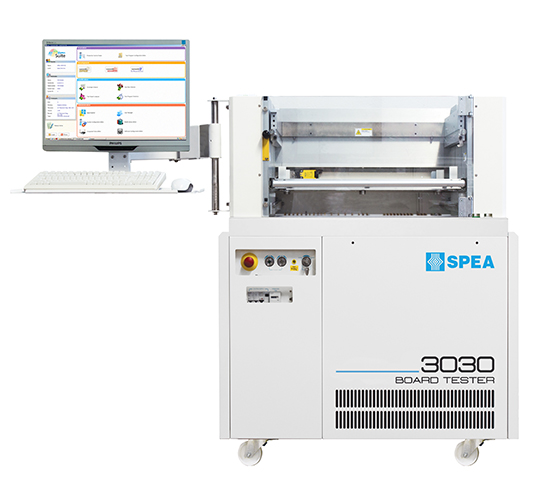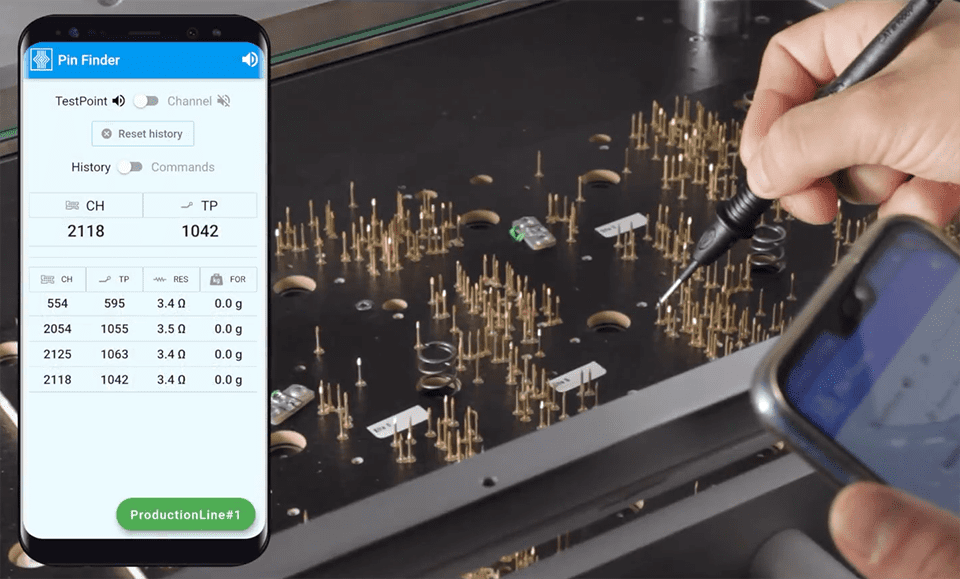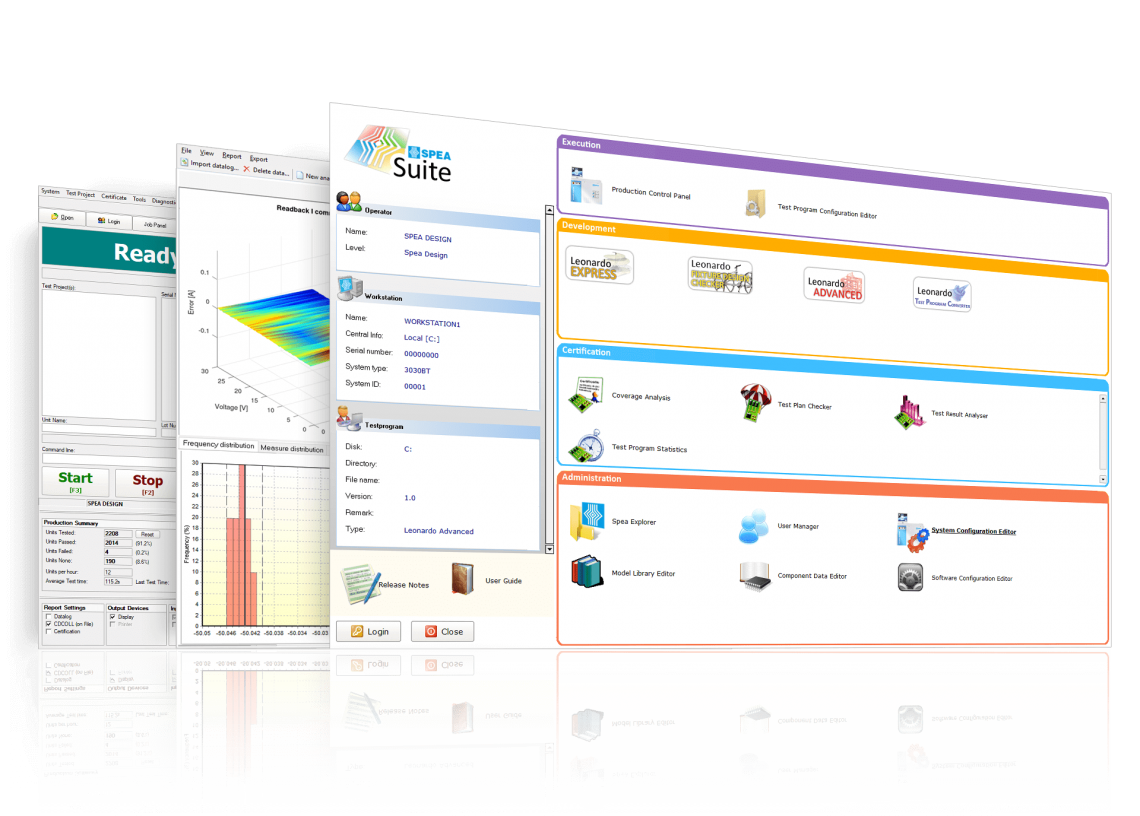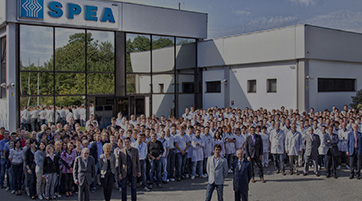Small footprint, high test coverage
3030C
MULTI-CORE SMALL FOOTPRINT BOARD TESTER

Key Features
- True 2x Parallel Test
- Small footprint
- High-speed parametric ICT
- Automatic application development
- Multiple test functions: ICT, FCT, Flashing
- Easy diagnostic of fixture’s pogo pins via mobile app
Compact. Powerful
3030C is the bed-of-nails tester designed to deliver a cost-effective test solution in a very small footprint. Modular and configurable with a complete range of instrumentation and receivers, 3030C provides 2x throughput compared with standard test solutions, thanks to its 2-Core Real Parallel Test. 3030C delivers multiple test capabilities, guaranteeing 100% coverage in a unique, integrated, high-throughput, cost-effective system.
True Parallel Test
True Parallel Test
3030C can be equipped with up to 2 independent Cores – each one with independent CPU, local memory and instrumentation – able to test in parallel up to 2 boards/panels of boards. Compared to standard ICT testers, 3030C throughput is up to 200% higher, thus minimizing the cost of board testing.
Saving cost of test
Saving cost of test
With True Parallel Multi-Core Architecture the cost of test is drastically reduced. Just one system, one operator, one handling, one fixture and one PC to test 2 PCBs at the same time.
PC-independent Architecture
PC-independent Architecture
With SPEA 3030 PC-independent Architecture the test program is resident in the tester CPU and the test speed is determined by the system CPU. Antivirus and other applications running on the PC do not affect the test speed. Moreover, you can change/update the PC at any moment, without having to re-debug the test program.
Forget field return
Forget field return
3030C has been designed to help electronics manufacturers boost their product quality. By executing various test techniques with its high-performance instrumentation and stimuli, 3030C can reliably find faults undetectable by functional testers and standard ICT tester.
Multi-device Parallel Flashing
Multi-device Parallel Flashing
3030C can be equipped with one or more 4-Core flashing modules, able to program in parallel different-type components. Flashing enables to program specific functions (BIST or BOST), as well as to load the system software on the ICs during the test stage, thus cutting the programming time and cost.
Precise contacting with SPEA’s receivers
Precise contacting with SPEA’s receivers
Tester and receiver are fully integrated, both designed by SPEA to provide a reliable cost-effective turnkey test equipment. Board contacting is safe and precise: when equipped with motorized receivers it is possible to program the presser speed according to the UUT characteristics. The descent is always planar, and it is also possible to program different contacting levels, so to execute different tests on different areas of the UUT. Direct cable-less connection between system instrumentation and fixture guarantees signal integrity. Finally, there is no need for compressed air: 3030C is easy to be moved everywhere in the plant.
Hi-speed parametric ICT
Hi-speed parametric ICT
SPEA 3030C Hi-speed ICT parametric test is able to measure each single component value in a very short time. Advantages: programming time reduction (the test is automatically generated), test time reduction (microseconds of ICT test vs. milliseconds of FCT), repairing time reduction (automatic fault device identification).
Test Capabilities
- Cost-effective Per-Pin Architecture
Each 3030C channel is configurable by test program. Every nail can be used to perform any kind of test. This instrument/receiver 1:1 ratio guarantees several benefits: faster test generation, easy ECO management, full flexibility. - Open Pin detection
Two different test techniques, Electro Scan and Junction Scan, can be executed for detecting open pins and other process defects in an easy and fast way. - Functional test
3030C testers provide not only functional test (FCT) at board level but also at cluster level. Programming is easy with Leonardo OS and by means of high level languages such as Microsoft C ++, Visual Basic, LabView.
- Upgradable & customizable
3030C can be factory-equipped or upgraded on field with the instrumentation needed to satisfy the test requirements. Finally, 3030C can accommodate a wide range of fixture receiver models, also from third parties (Genrad, Ingun, Zentel, Augat Pylon…).
- Boundary Scan: test inaccessible parts
The Boundary Scan technique is able to test non-accessible nets and components. The simultaneous use of Boundary Scan technique with SPEA 3030C ICT instrumentation allows to increase the test coverage reducing at the same time the fixture costs (virtual test points instead of real test nails).
- Fixture & Test Program migration
SPEA Common Architecture allows Leonardo OS Test Programs to work with all SPEA board testing systems, 3030 and even Flying Probe testers. You can quickly move your production from one system to another, depending on the production needs.

Faster fixture’s pogo pins diagnostic with the Pin Finder App
The Pin Finder App is a mobile application that makes pogo pins and tester’s channel integrity verification faster and easier.
The app allows you to carry out the pogo pins’ diagnostics without having to remove the fixture from the tester.
By probing each pogo pin and viewing the measured data via the Pin Finder App, you can quickly verify each channel by measuring its resistive value and associated test point.
The app displays the pogo pins’ information in real-time. It also features a text-to-speech function to ease the diagnostic operations and avoid looking at the smartphone screen at each measurement.

Leonardo. Easy. Fast. Self-programming
- Automatic test program generation in minutes
- Automatic debug & tuning
- Minimized application development costs: automatic generation of the file for fixture drilling and wiring
- Automatic CAD data recognition & import
- Automatic test report generation
- User-friendly intuitive graphical interface
- Real time production monitoring and analysis


